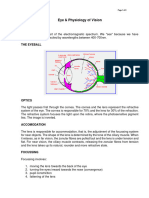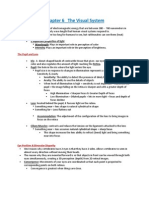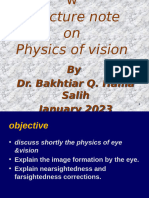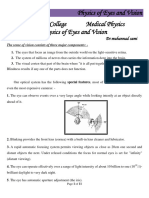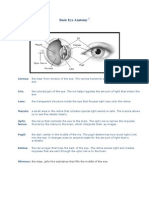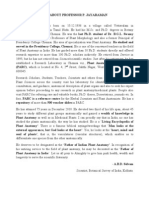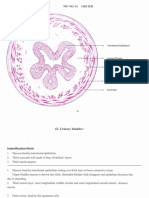0 ratings0% found this document useful (0 votes)
3 viewsHuman Eye: A Human Eyeball Is Like A Simple Camera!
Human Eye: A Human Eyeball Is Like A Simple Camera!
Uploaded by
zein0217zienCopyright:
© All Rights Reserved
Available Formats
Download as PPT, PDF, TXT or read online from Scribd
Human Eye: A Human Eyeball Is Like A Simple Camera!
Human Eye: A Human Eyeball Is Like A Simple Camera!
Uploaded by
zein0217zien0 ratings0% found this document useful (0 votes)
3 views18 pagesOriginal Title
L15
Copyright
© © All Rights Reserved
Available Formats
PPT, PDF, TXT or read online from Scribd
Share this document
Did you find this document useful?
Is this content inappropriate?
Copyright:
© All Rights Reserved
Available Formats
Download as PPT, PDF, TXT or read online from Scribd
Download as ppt, pdf, or txt
0 ratings0% found this document useful (0 votes)
3 views18 pagesHuman Eye: A Human Eyeball Is Like A Simple Camera!
Human Eye: A Human Eyeball Is Like A Simple Camera!
Uploaded by
zein0217zienCopyright:
© All Rights Reserved
Available Formats
Download as PPT, PDF, TXT or read online from Scribd
Download as ppt, pdf, or txt
You are on page 1of 18
Human Eye
A human eyeball is like a simple camera!
Sclera: outer walls, hard, like a light-tight box.
Cornea and crystalline lens (eyelens): the two
lens system.
Retina: at the back of eyeball, like the film.
Iris: like diaphragms or stop in a camera.
Pupil: camera aperture.
Eyelid: lens cover.
Sclera (The white/non-transparent tissue surrounding the cornea)
Aqueous humor and Vitreous humor
The Aqueous Humor is the clear liquid between the
cornea and the lens. It has the benefit of being fairly
homogenous and, as a result, the optical properties
are easily measured. (Le Grand, 1967)
The space that it inhabits is called the anterior
chamber.
The Vitreous Humor is the clear liquid between the
lens and the retina.
The space that it fills is called the vitreous body.
Functions?
Provides nourishment to the eyelens and cornea.
Cannot use the blood vessels:
Will block the light.
Easy for surgical transplant.
Hold the shape of the eyeball.
Focusing
The cornea and eyelens form a compound lens
system, producing a real inverted image on the
retina.
From air to cornea (n=1.376): large bending, the main
focusing.
From cornea to eyelens (n=1.406), less focusing power.
(Eyelens can develop white cloudiness when getting old:
Cataracts.)
The eye has a limited depth of field. We cannot see
things close and far at the same time.
Accommodation
The eye focusing is not done by change the distance
between the lens and retina. Rather, it is done by
changing the focal length of the eyelens! Ciliary
muscles help to change the shape of the lens:
accommodation.
Muscles relax, long focal length, see objects far way;
Muscles tense, short focal length see objects close.
Normal eyes can see 25cm to infinity, however, if the
cornea bulges too much or too little. The accommodation
does not help. (myopia or hyperopia)
The Iris
When it is full open, it is about f/2 and f/3.
This happens at low light level.
When the iris has a small opening, it can cut
down the light intensity by a factor of 20.
However, the main function of stopping down
the iris is to increase the depth of field.
Retina Structure
Light sensitive layer is made of photo-
receptors: rods (120 millions) and cones (7
millions) which absorb the light.
Plexiform Layer: nerve cells that process
the signals generated by rods and cones and
relay them to the optical nerve.
Choroid: carries mayor blood vessels to
nourish the retina and absorb the light so
that it will not be reflected back (dark
pupil!)
Rods and Cones
Covers an area of 5 cm2. A baseball a mile
away gives an image covering one cone.
Cones: for more precise vision, need strong
light. help to see colors. Mostly distributed
in the center of the retina (fovea).
Rods: for peripheral and night vision.
Sensitive to light. Mostly distributed away
from fovea.
Sensitivity
Cones: slow, fine grain, like color film.
Need high level of light (photopic condition, day)
High density, high resolution.
Rods: fast, coarse grain, black & white film
Low level of light (scotopic condition, at night)
No color is obvious.
Adaptation: Changing of retina sensitivity.
Singal Processing
Trace the signal through the retina:
The retina is a seven-layered structure involved in
signal transduction.
Light enters from the GCL side first, and must
penetrate all cell types before reaching the rods and
cones.
The outer segments of the rods and cones transduce
the light and send the signal through the cell bodies of
the ONL and out to their axons.
In the OPL photoreceptor axons contact the
dendrites of bipolar cells and horizontal
cells. Horizontal cells are interneurons
which aid in signal processing
The bipolar cells in the INL process input
from photoreceptors and horizontal cells,
and transmit the signal to their axons.
In the IPL, bipolar axons contact ganglion
cell dendrites and amacrine cells, another
class of interneurons.
The ganglion cells of the GCL send their
axons through the OFL to the optic disk to
make up the optic nerve. They travel all the
way to the lateral geniculate nucleus.
Fovea
The fovea defines the center of the retina, and
is the region of highest visual acuity. The
fovea is directed towards whatever object you
wish to study most closely - this sentence, at
the moment. In the fovea there are almost
exclusively cones, and they are at their
highest density.
Processing Time
Latency: it takes a bit time for the cells in
retina to respond to a flash of light.
Persistence of response: the response does
not stop at the instant the flash stops.
1/25 second at low intensity, 1/50 second at high
intensity.
The persistence allows as to see moving things
clearly.
You might also like
- Yasser El Miedany Musculoskeletal Ultrasound Guided RegenerativeDocument554 pagesYasser El Miedany Musculoskeletal Ultrasound Guided RegenerativeMarielly EllerNo ratings yet
- AP2 Unit 6 Exam Review CASDocument12 pagesAP2 Unit 6 Exam Review CASMarera DomnicNo ratings yet
- Human Eye: A Human Eyeball Is Like A Simple Camera!Document18 pagesHuman Eye: A Human Eyeball Is Like A Simple Camera!ljieNo ratings yet
- Human Eye: A Human Eyeball Is Like A Simple Camera!Document18 pagesHuman Eye: A Human Eyeball Is Like A Simple Camera!fidansekizNo ratings yet
- Human Eye: A Human Eyeball Is Like A Simple Camera!Document33 pagesHuman Eye: A Human Eyeball Is Like A Simple Camera!Joana CastilloNo ratings yet
- Sensory System - EyesDocument5 pagesSensory System - EyesTanvi NanniNo ratings yet
- 0 OphthalmologyDocument12 pages0 OphthalmologyParsaant SinghNo ratings yet
- The Human EyeDocument3 pagesThe Human EyeKajetano GraucosNo ratings yet
- Sense Organs: The EyesDocument8 pagesSense Organs: The EyesGeet LagadNo ratings yet
- 3.2 Sense OrganDocument8 pages3.2 Sense OrganMod HollNo ratings yet
- Visual and AuditoryDocument7 pagesVisual and AuditoryChristi EspinosaNo ratings yet
- Anatomy of Eyes-BiopsyDocument20 pagesAnatomy of Eyes-BiopsynandanitriadiningsihNo ratings yet
- Chapter 11 Sense OrgansDocument5 pagesChapter 11 Sense Organszuni2008siddiquiNo ratings yet
- The Human Eye and The Colourful WorldDocument33 pagesThe Human Eye and The Colourful WorldHarshit GoelNo ratings yet
- Structure of The EyeDocument5 pagesStructure of The Eyetanupaul73473No ratings yet
- 27 Physiology of Visual AnalyzerDocument39 pages27 Physiology of Visual Analyzersiwap34656No ratings yet
- What Makes Up An EyeDocument3 pagesWhat Makes Up An EyenandhantammisettyNo ratings yet
- Biology Eye NotesDocument12 pagesBiology Eye NotesBalakrishnan MarappanNo ratings yet
- The Eye and VisionDocument70 pagesThe Eye and VisionLedkos SLNo ratings yet
- Human Visual System (Disowner)Document4 pagesHuman Visual System (Disowner)Christelle ZuluetaNo ratings yet
- Structure and Function of The EyesDocument5 pagesStructure and Function of The EyesPreeti ShuklaNo ratings yet
- Human EyeDocument54 pagesHuman EyeRadu VisanNo ratings yet
- CNS 03 VisualDocument15 pagesCNS 03 VisualJeff ParkNo ratings yet
- BN Unit 2Document12 pagesBN Unit 2Mir BushraNo ratings yet
- Vision-Lecture Notes-RskDocument6 pagesVision-Lecture Notes-Rskdevilalshingh9525No ratings yet
- Vision: Chapter 9: SensesDocument21 pagesVision: Chapter 9: SenseshoneykrizelNo ratings yet
- Structure and Function of EyesDocument11 pagesStructure and Function of EyesSamar Ameen SialNo ratings yet
- 14.9a Eye and VisionDocument40 pages14.9a Eye and VisionsotheenathansaideepikaaNo ratings yet
- Bio Psychology Lecture Notes Chapter 6 The Visual SystemDocument7 pagesBio Psychology Lecture Notes Chapter 6 The Visual SystemGeneric_Persona50% (2)
- Lecture Notes 5Document3 pagesLecture Notes 5Carol RiveraNo ratings yet
- The Main Parts of The Eye and Their FunctionDocument5 pagesThe Main Parts of The Eye and Their FunctionJoshuaNo ratings yet
- The EyeDocument6 pagesThe EyeDebiprasad GhoshNo ratings yet
- Physics of Eye and Vision - Updated DR Bakhtiar 2023Document46 pagesPhysics of Eye and Vision - Updated DR Bakhtiar 2023mhamadmhamad1184No ratings yet
- Human Eye Structure and Defects of VisionDocument25 pagesHuman Eye Structure and Defects of Visionmailansh904No ratings yet
- Structure of Eye !Document11 pagesStructure of Eye !Leonora KadriuNo ratings yet
- Publication 4 8578 1650Document9 pagesPublication 4 8578 1650NIKHILA RAKESHNo ratings yet
- Physics of Eye and Vision: The Sense of Vision Consists of Major ComponentsDocument8 pagesPhysics of Eye and Vision: The Sense of Vision Consists of Major ComponentsAdnan aliNo ratings yet
- Sensorineural Function CorrectedDocument61 pagesSensorineural Function CorrectedEmilyjNo ratings yet
- Bionic Eye EB KNS 2019Document58 pagesBionic Eye EB KNS 2019Lalitaditya DivakarlaNo ratings yet
- Eye PDFDocument19 pagesEye PDFDebbie MeyerNo ratings yet
- Eye Lecture GuideDocument46 pagesEye Lecture Guidemaj0% (1)
- Physics of Eyes and Vision Dentistry College Medical Physics Physics of Eyes and VisionDocument11 pagesPhysics of Eyes and Vision Dentistry College Medical Physics Physics of Eyes and VisionNIKHILA RAKESHNo ratings yet
- Nervous System - Part 12 Dr. Baya (Ch.50.3)Document81 pagesNervous System - Part 12 Dr. Baya (Ch.50.3)dr.shorouq.m777No ratings yet
- 5 - VisionDocument7 pages5 - VisionJamesMontisNo ratings yet
- Human EyeDocument12 pagesHuman Eyeanu rettiNo ratings yet
- Nes-Grade 9 - Unit 1: Edited By: Aliaa MuhammedDocument25 pagesNes-Grade 9 - Unit 1: Edited By: Aliaa MuhammedMagd OsamaNo ratings yet
- Human SensesDocument6 pagesHuman Sensesvicky7No ratings yet
- Physics of Eyes and VisionDocument57 pagesPhysics of Eyes and VisionNIKHILA RAKESHNo ratings yet
- Sense Organs: Structure of Human EyeDocument8 pagesSense Organs: Structure of Human EyeRanveer SinghNo ratings yet
- Structure and Functioning of Human EyeDocument4 pagesStructure and Functioning of Human Eyeaati RajputNo ratings yet
- PP15-Receptors-The-Eye Human Nervous SystemDocument108 pagesPP15-Receptors-The-Eye Human Nervous Systemnomthandazolanga657No ratings yet
- An Organ That Receives and Relays Information About The Body's Senses To The BrainDocument59 pagesAn Organ That Receives and Relays Information About The Body's Senses To The BrainIsarra AmsaluNo ratings yet
- Basic Eye Anatomy: CorneaDocument6 pagesBasic Eye Anatomy: CorneaGayatri Gaur100% (1)
- Vision BPTDocument110 pagesVision BPTAkshay BadoreNo ratings yet
- Crash Course VisionDocument2 pagesCrash Course VisionReem SleemNo ratings yet
- VisionDocument12 pagesVisionrajeeljavedNo ratings yet
- The Human EyeDocument21 pagesThe Human EyeMichel ThorupNo ratings yet
- Human Eye and The Colorful WorldDocument53 pagesHuman Eye and The Colorful WorldM SreehithaNo ratings yet
- Special Sense EYEDocument74 pagesSpecial Sense EYEprekshya shresthaNo ratings yet
- Low Vision: Assessment and Educational Needs: A Guide to Teachers and ParentsFrom EverandLow Vision: Assessment and Educational Needs: A Guide to Teachers and ParentsNo ratings yet
- A Simple Guide to the Eye and Its Disorders, Diagnosis, Treatment and Related ConditionsFrom EverandA Simple Guide to the Eye and Its Disorders, Diagnosis, Treatment and Related ConditionsNo ratings yet
- Exercises On Cell and TissuesDocument14 pagesExercises On Cell and TissueskamilNo ratings yet
- Dhruv Biology FinalDocument15 pagesDhruv Biology FinaldhruvlaltikarNo ratings yet
- Life Processes-Question BankDocument9 pagesLife Processes-Question Bankkfjg47zq26No ratings yet
- Animal Genetics and Breeding (PDFDrive)Document208 pagesAnimal Genetics and Breeding (PDFDrive)Hồng Quân DươngNo ratings yet
- Final SK Golden 7+8 ErrataDocument19 pagesFinal SK Golden 7+8 ErrataHassam ZulfiqarNo ratings yet
- Al Najm:38 39Document16 pagesAl Najm:38 39حمزہ محبNo ratings yet
- All About Prof. P. JayaramanDocument1 pageAll About Prof. P. JayaramanDr. A.B.D. SelvamNo ratings yet
- Grading of OsccDocument18 pagesGrading of OsccROHITHNo ratings yet
- Revised Case Study Umbilical HerniaDocument14 pagesRevised Case Study Umbilical HerniaLance Angelo Bernandino100% (1)
- Histology Notes 3Document47 pagesHistology Notes 3Ju WenNo ratings yet
- Tunica Serosa/ Adventitia: Gastrointestinal TractDocument6 pagesTunica Serosa/ Adventitia: Gastrointestinal TractDanielle CapangpanganNo ratings yet
- External & Internal Features of Spinal CordDocument77 pagesExternal & Internal Features of Spinal CordPatricia Hariramani100% (2)
- The Incredible Human BodyDocument15 pagesThe Incredible Human BodyArki TorniNo ratings yet
- Protein Sorting: Dr. Narendhirakannan RT Assistant Professor Department of BiochemistryDocument43 pagesProtein Sorting: Dr. Narendhirakannan RT Assistant Professor Department of Biochemistryمروة صلاح100% (1)
- CH 4 Notes Sensation and PerceptionDocument99 pagesCH 4 Notes Sensation and Perceptionapi-261300427No ratings yet
- Stem Cells in DentistryDocument5 pagesStem Cells in DentistryTeodoraHoriceanuNo ratings yet
- Hepatomegaly PDFDocument9 pagesHepatomegaly PDFKhadija IbrahimNo ratings yet
- Biotechnology - Deniz Ekinci (AvE4EvA, 2015)Document240 pagesBiotechnology - Deniz Ekinci (AvE4EvA, 2015)WinstienNo ratings yet
- XIYAN (MN-LE-16) : Eyes of The KneeDocument1 pageXIYAN (MN-LE-16) : Eyes of The Kneeray72roNo ratings yet
- Basic Immunology - PML 311 Course Outline - 29th August 2023Document3 pagesBasic Immunology - PML 311 Course Outline - 29th August 2023Isaac PopsmokeNo ratings yet
- Anatomi Abdomen Dan DD Berdasarkan Pembagian Regio AbdomenDocument4 pagesAnatomi Abdomen Dan DD Berdasarkan Pembagian Regio Abdomenhenry bonifaciusNo ratings yet
- Physiology and Injuries in SportsDocument41 pagesPhysiology and Injuries in SportsAdarsh KashyapNo ratings yet
- Animal Cell: Parts of Plant CellDocument2 pagesAnimal Cell: Parts of Plant CellMavi IvamNo ratings yet
- Anatomy of Oral Cavity, Pharynx and EsophagusDocument52 pagesAnatomy of Oral Cavity, Pharynx and EsophagusYashoda Amarasekera100% (1)
- Enhanced Science 8 Q4 Week 1Document1 pageEnhanced Science 8 Q4 Week 1chl03b4y09No ratings yet
- Nervous System WorksheetDocument6 pagesNervous System WorksheetSteve MacarioNo ratings yet
- Lymphedema 101: Part 1: Understanding The Pathology and DiagnosisDocument5 pagesLymphedema 101: Part 1: Understanding The Pathology and DiagnosisSAKAI69100% (1)
- Body Comp & Diaph Mov - Normal Diaphragmatic Motion and The Effects of Body Composition Determination With M-Mode Sonography PDFDocument6 pagesBody Comp & Diaph Mov - Normal Diaphragmatic Motion and The Effects of Body Composition Determination With M-Mode Sonography PDFnirchennNo ratings yet
























